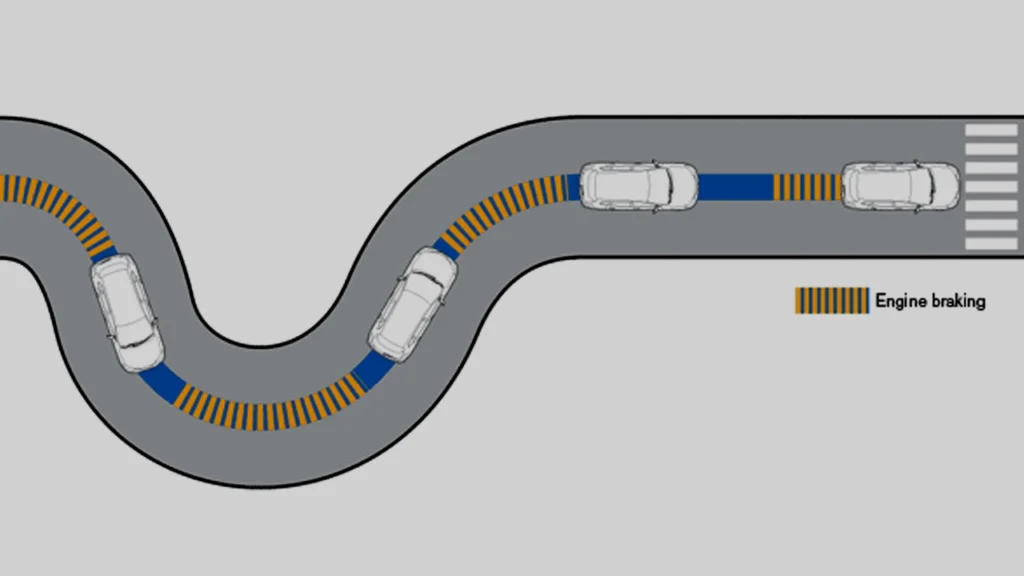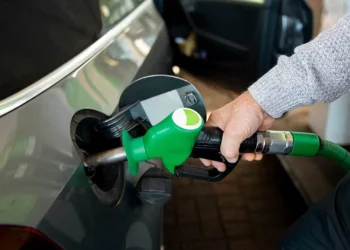Footbraking is the most frequently applied method to manage your speed; be it doing it in an emergency or under standard circumstances. By the extent of pressure applied on the brake pedal, you decide with how much speed, where and when to stop as well as when to proceed again.
However, the footbrake is not the only option one has when they need to slow down the car. Though it is less often used, engine braking is rather effective in making your car more efficient and prolonging the lifespan of the brakes.
What Is Engine Braking?

Engine braking involves slowing your car by taking your foot off the accelerator and shifting down through the gears. But how exactly does engine braking function?
In standard gasoline vehicles, engine braking limits airflow to the engine, creating decelerative forces that reduce the wheel’s rotational speed. When you lift your foot off the accelerator pedal, the throttle body valve closes quickly. The engine continues to draw in air, but with the throttle body valve closed, only a small amount of air reaches the engine.
This creates a high manifold vacuum that the cylinders must work against. Due to the vacuum, the engine’s energy decreases, leading to a drop in power and a reduction in wheel speed. Although engine braking is more effective in manual transmission cars and fire engines, it also works with automatic transmissions.
Engine Braking in Diesels
Diesel engines are more efficient than gas engines and do not have engine braking in the sense that gasoline engines do. Unlike gasoline engines, diesel engines do not use throttle valves to control engine power; they vary fuel flow to the fuel injectors. Because they do not maintain a throttle vacuum, they are not subjected to the same engine braking effects.
What diesel engine engineers have built is a unique device called a Jacobs Brake (Jake Brake). The way they work is that the exhaust valves are opened at the top of the compression stroke, so the large amount of energy stored in that compressed air is not returned to the crankshaft.
Here’s how it works: Normally during the compression stroke, energy is used as the piston compresses air in the cylinder; the compressed air then acts as a compressed spring and pushes the piston back down. However, with the Jake brake in operation, the compressed air is suddenly released just before the piston begins its downward stroke. Having lost the energy stored within the compressed air, there is no “spring back” so the engine must expend yet more energy pulling the piston back down again. This retarding force is transmitted to the vehicles wheels and the vehicle slows down.
Engine Braking in Hybrid and Electric Vehicles
Things change a bit when electric motors are in play. For hybrids, slowing down off-throttle often involves regenerative braking, where the electric motor captures energy to charge the battery, yet the engine can still assist in braking. Some hybrids feature an L or B mode to enhance regen and add engine braking if needed.
In an electric vehicle (EV), there’s no engine, but braking happens mechanically at the rotors and through regen from the motor(s). Since most EVs have a single gear, you can’t pick a different transmission mode, but the driver can usually increase the standard regen level to minimize friction brake use. Additionally, some EVs have a paddle that, when pulled, boosts regen instantly.
Regenerative brakes
The second type of brake is the regenerative brake. These systems capitalize on the similarities in the construction of electric motors and electric generators. An electric motor’s interior is made up of copper windings wound on an armature. It uses an electromagnetic energy field to produce torque. A generator is also comprised of copper windings on an armature and this allows it to produce electric power when it is turned.
In a regenerative braking system, the goal is to reclaim the energy produced when brakes are used. Pressing the brake pedal switches the regenerative braking circuit, causing the motor to enter “generator mode” and work in reverse to oppose the wheel’s direction. The generated electricity is then led to renew the car’s storage batteries. (Note: at higher speeds, regenerative brakes still need the support of traditional friction brake systems as a backup)
The efficiency of regenerative braking systems in use today is high. The technicians at East Hills Subaru of Roslyn, a local Subaru dealer in Roslyn, NY, tell us that the regenerative braking systems used on the Crosstrek Hybrid are able to capture and store as much as 70 percent of the energy that would otherwise have been lost to heat.
When will you feel the effects of engine braking?
You can feel the effects of engine braking as soon as you lift your foot off the accelerator pedal. Decelerating the vehicle down by altering to lower gears is also doable. Both techniques decrease the vehicle’s speed without using the brake. However, keeping your engine in optimal condition would require regular changing of engine oil and performing maintenance checks.
How can you employ your powerplant as a brake?
- Engine braking is quite straightforward, and you’ve likely done it before, even without realizing it.
- Picture a traffic light ahead while you’re driving at 40mph. To slow down gradually, stop accelerating and shift down through the gears one at a time.
- Make sure to match your revs as you downshift, slowly and smoothly releasing the clutch each time—this prevents the uncomfortable jolt from downshifting too quickly.
- Engine braking won’t bring you to a complete stop, so you’ll need to use the clutch and brake to stop fully. This method reduces brake wear while ensuring a safe stop!
Is engine braking deemed a bad maneuver?
Engine braking isn’t necessarily a bad habit on its own, but it could gradually affect your vehicle negatively. One key issue is that engine braking doesn’t activate your brake lights, so other drivers might not realize you’re slowing down. In sudden or emergency situations, depending solely on engine braking might not deliver the quick deceleration needed to prevent an accident. Additionally, engine braking can create noise that other drivers might find annoying or disruptive.
When is the ideal time to employ engine braking?
If you decide to use engine braking, ensure it’s only in appropriate conditions.
- Engine braking on snow, ice, or downhills will provide smoother deceleration and offer better vehicle control.
- While improper use might increase clutch or transmission wear, engine braking can lessen brake disc and pad wear.
- This is particularly beneficial during long motorway trips, as it helps manage speed without frequently applying the brake pedal.
- Regular maintenance, including keeping the engine compartment clean, ensures that all components function properly, supporting efficient engine braking and overall vehicle performance.











